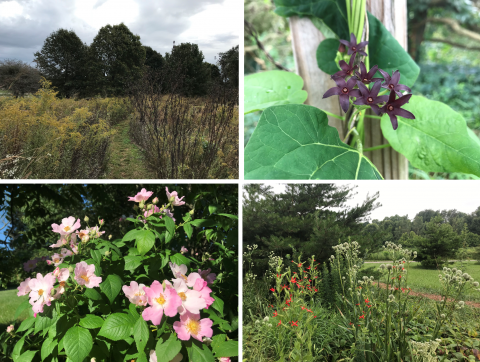Pennyrile Region
 The Pennyrile region is the second largest collection at The Arboretum, where it forms the bulk of our eastern border. One of the most indicative features in this collection are the large tallgrass prairie ecosystems, whose tall stems of grasses and wildflowers provide food and shelter for numerous birds and insects.
The Pennyrile region is the second largest collection at The Arboretum, where it forms the bulk of our eastern border. One of the most indicative features in this collection are the large tallgrass prairie ecosystems, whose tall stems of grasses and wildflowers provide food and shelter for numerous birds and insects.
The prairies are a fascinating exhibit to watch throughout the year, as their successional cycle of flowering continues and gives rise to wonderful fall color and architecture.
Much like what occurs naturally, The Arboretum staff and volunteers burn the prairies on an annual basis. This fire management is typically the only maintenance the prairies receive each year.
Oaks form the major component of all Kentucky’s forests, and in the Pennyrile collection the blackjack oak, post oak, and white oaks dominate. Along with sugar maple, various species of hickory and elm are also abundant in here.
Less common woody plants in the Pennyrile include sugarberry, scentless mock orange, sourwood, persimmon, and Carolina buckthorn.
From "The Big Picture: Ecological Regions of Kentucky" by Dr. Julian Campbell:
“The Pennyrile corresponds to the predominately calcareous areas with Mississippian bedrock in Kentucky (ca. 340-350 million years old). Within our state, this is a large complex region with fingers, attenuations and disjunct pieces. This region forms a vast plateau to the south of the famous Bluegrass limestones and the Knobs Region, and it contains the other great limestone plains and rolling hills in Kentucky.
"The most extensive pure limestone occurs in a large western band forming the true Pennyrile region. These ‘karst plains’ are particularly flat, and water has dissolved the surface into sinkholes and lengthy cave systems. Despite the historical term ‘barrens’ for some areas, the upland soils are moderately fertile, though prone to drought in dry years.
"Common forest types for Kentucky have developed over much of this region. Wet depressions support swampy forest with several unusual plant species. However, on the droughty karst plains, during warmer climates after the last ice age, the forest began to give way to native grassland, eventually including the ‘Big Barrens’ and ‘Great Meadows’ of pioneers.”
